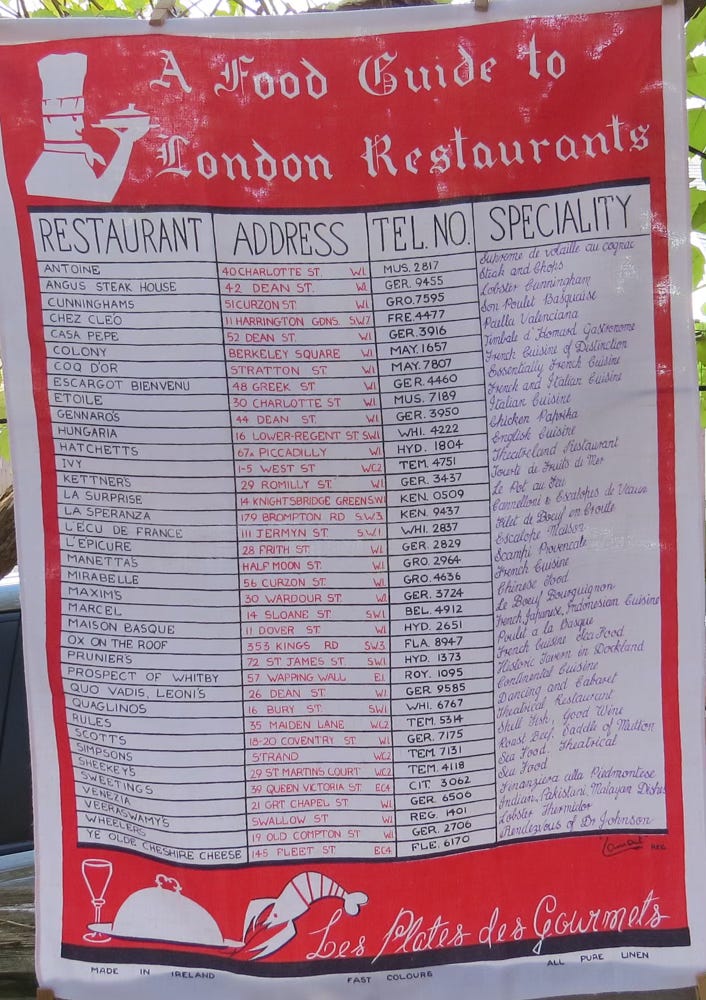After too many days of doom-scrolling and post-election despair, the end of the week offered a chance for normalcy. I was rewarded at a Friday estate sale with a Lamont linen towel, a food guide to London restaurants. It conjured up memories of a happy trip to London.
Mother and I crossed the pond back in 1991, and spent eight days walking around London and visiting a few towns nearby that were settings for the novels and films central to my graduate thesis.
It was a marvelous trip. It rained everyday and the strap on my camera bag broke, so we bought umbrellas and a school bag in Portobello Street. We visited Poet’s Corner in Westminster Abbey, went to a nighttime ceremony at the Tower of London, then ventured out to towns featured in Thomas Hardy’s novels and Lyme Regis, home to John Fowles and setting for The French Lieutenant’s Woman.
We budgeted spending about $100 a day for food and lodging. Which meant we visited none of the restaurants listed on the Lamont towel. Sticking to the original itinerary of visiting literary and cinematic sites, here’s what we missed while in London:
In Covent Garden, Rules was featured in “Downton Abbey” as Edith Crawley’s favorite meeting place. Established in 1798, the restaurant bills itself as London’s oldest restaurant (a distinction claimed by many London eateries). The menu features traditional British dishes, including game.
Actually, the distinction of “oldest” should go to Prospect on Whitby, an early 16th century tavern in the Dockland district, along with Ye Olde Cheshire Cheese, a mid-17th-century pub near Fleet Street. The towel claims the latter was a “rendezvous of Dr. Johnson.” Others claim Mark Twain and Charles Dickens supped there, too.
Etoile on Charlotte Street: Yelp calls it a “buzzy glamorous French-style bistro.” Alfred Hitchcock and Charles Laughton called it one of their favorite London eateries.
Gennaro’s on Dean Street: Several movies were filmed at the restaurant, including “Secret Agent” and “What a Woman Wants.” I wonder if the kitchen shut down during filming or if the actors and cameramen were able to sample Gennaro’s Italian cuisine.
I might wander to the original location of Hungaria on Lower Regent Street, just because of its intriguing wartime advertising. “Bomb-proof; Splinter-proof, Blast-proof, and BOREDOM PROOF – We care for your safety as well as your pleasure.” Blitz bombing be damned!
To figure out how old this towel might be, I searched out every restaurant listed. Most of the establishments named on the towel are still in business, so an internet search was not particularly helpful for determining age.
The best clue for age comes from the phone numbers listed for each establishment – an alpha-numeric configuration in which an abbreviated district name was paired with a set of numbers unique to each telephone location. For example, the number for Maison Basque is listed as “HYD.2651”; the three letters indicate its location in Hyde Park. As the number of businesses and households with telephones increased, the alpha-numeric system became cumbersome and inaccurate. In the United States and Canada, the change-over to 10-digit numbers started in the mid-1950s. In London, the alpha-numeric system began to be phased out around 1966; I read one account that suggested a nationwide changeover wasn’t complete until the early 1990s.
Looking back, I’m amazed we were able to travel around England on such a tight budget -- $100 might not buy a plate in some of the restaurants listed on the towel. Still, we ate well at B&B’s or local pubs. That said, if I ever get back to London, I’m taking this towel along!






